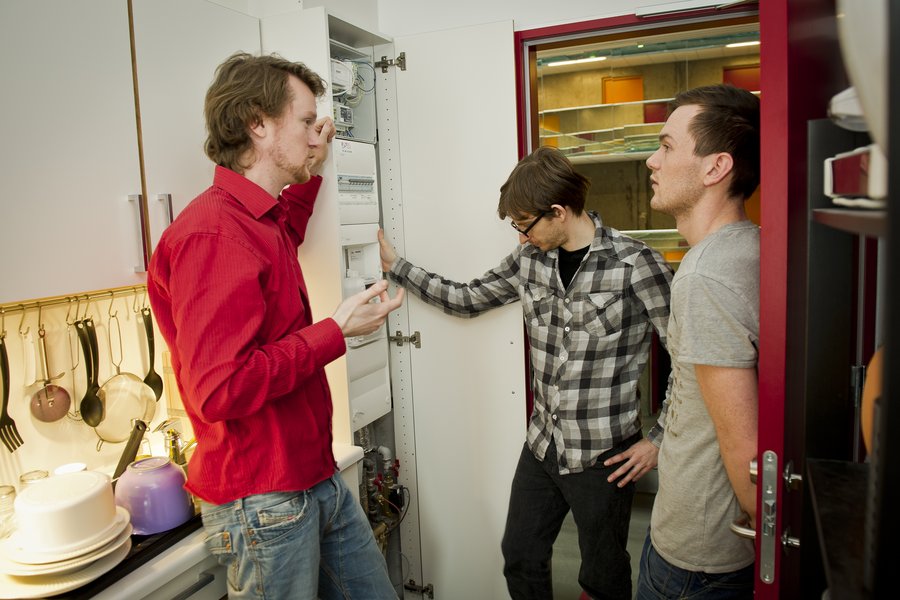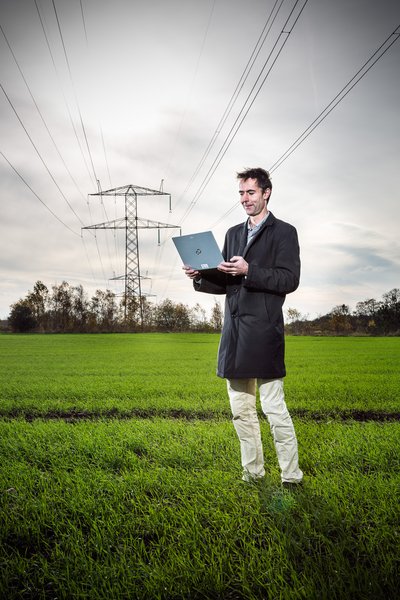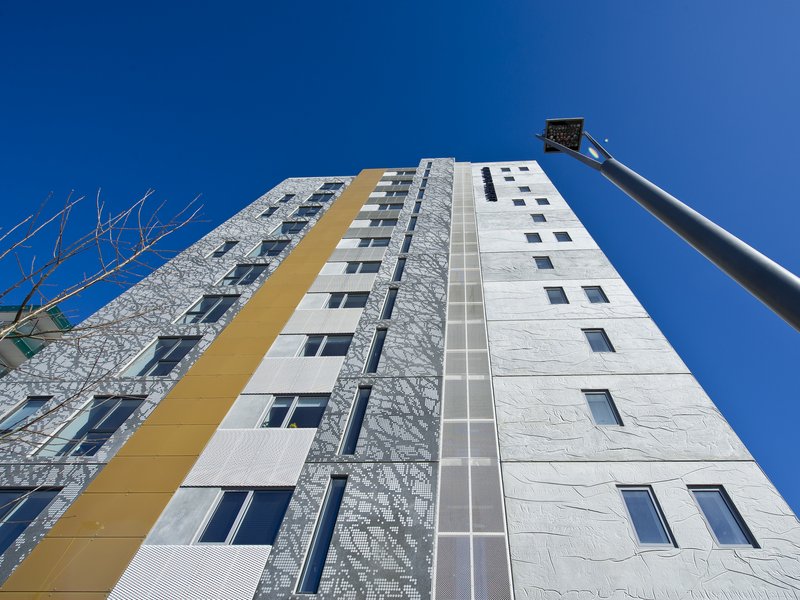Intelligent buildings
Virtual Power Plant for Smart Grid Ready Buildings and Customers
The research project VPP4SGR - Virtual Power Plant for Smart Grid Ready Buildings and Customers - uses a dormitory in Aarhus as a full scale energy lab.
The researchers have carried out the world's most radical energy monitoring program. For 24 hours a day, the researchers have logged the energy usage, humidity level, CO2 emission and flow of water, heat and electricity with a few seconds interval for the apartments in the Grundfos dormitory.
Furthermore, weather prognoses such as temperature, wind conditions, and the direction of the sun have been integrated in the advanced demand response algorithms.
Demand response
The goal is smart regulation of the building's total heat and ventilation with the lowest possible energy use and optimal comfort level for the residents.
Knowledge about future electricity prices and weather forecasts, plays an essential role in determining the demand response potential. These external factors are used as input in the dynamic control of the VPP.
While electricity prices are governed by market mechanisms, the weather forecast that includes for instance temperature variation and wind chill factors, needs to be taken from a coarser grained prognosis down to the building level.
In the VPP4SGR project, researches investigate the potential of using local weather forecast in the intelligent control of the VPP.
Strong ZigBee network
The Grundfos dormitory is a huge mesh network with ZigBee communication at all 12 floors.
There is only one hub on each floor. This wireless hub serves as network coordinator and collects data from all meters, smart plugs, sensors, etc. from all apartments on this floor.
Develco Products in VPP4SGR
Develco Products delivers a lot of equipment for the Grundfos dormitory.
Among other things, Develco Products has provided all 150 apartments with wireless meter interfaces. The ZigBee interface has often been inserted in the electricity meter by the residents/end-users themselves.
Develco Products has furthermore equipped every door in the large building with a door/window sensor in order to monitor the traffic in and out of the building and compare this to the use of the elevator. We made an elevator trial where we investigated the potential of affecting people's use of the elevator in accordance with the renewable energy production in the grid.
Develco Products has also provided numerous gateways, sensors, smart plugs and many other products for the smart building.
Partners
- Aarhus University
- Aarhus Kommune
- Alexandra Instituttet
- Develco Products A/S
- Grundfos Holding A/S
- DONG Energy A/S
Case study 1: "Green" elevators
Having a guilty conscience about the climate makes us choose to take the stairs instead of the energy-devouring elevator – at least to a certain extent. Develco Products provided the project with lamps informing about carbon dioxide intensity in order to significantly reduce the use of the elevator in the building. Below you will find the conclusion of a research project involving almost 200 residents in a 12-storey building in Aarhus.
Simple technology makes elevators ‘green’
It stays remarkably still – the elevator at the Grundfos hall of residence at the Port of Aarhus.
“It’s because electricity is ‘red’,” explains Associate Professor Rune Hylsberg Jacobsen.
When the red lamp lights up in front of the elevator, it is because the available energy has a high carbon dioxide intensity with a deficit of energy from sustainable energy sources.
When the green lamp is showing, it is typically because the wind turbines are hard at work, which means the power has a low carbon dioxide intensity.
The Grundfos hall of residence acts as a full-scale energy laboratory, where Develco Products with cooperation of its partners has carried out one of the world’s most radical energy monitoring experiments for a period of three years.

The elevator is used in windy weather
The extent to which the energy consumption of a group of residents can be influenced by providing them with information about considerate behaviour and appealing to their conscience has been studied.
The vast majority of new buildings today are constructed according to standards that ensure a very high level of energy efficiency, so it therefore makes good sense to look for the potential for energy savings entirely elsewhere.
“If we want to reduce energy consumption in extremely energy-efficient buildings, there’s no point in looking at whether we can squeeze in an extra layer of insulation. On the contrary, we should be taking an interest in the part of the energy consumption the residents themselves are responsible for. The major challenge is to highlight the consumption and thereby help them to adopt behaviour that’s adapted to a lifestyle with power from sustainable sources,” explains Associate Professor Rune Hylsberg Jacobsen.
The elevator experiment is the first of its kind to suggest opportunities for influencing power consumption at such a scale as to achieve a better balance with fluctuating energy supplies.
“We’ve studied whether we can motivate the building’s residents to use power when it has a low carbon dioxide intensity, simply by informing them. And it looks promising. If we can get the residents to take the stairs to some extent simply by appealing to their conscience, it looks as though we can also get them to change a considerable number of other habits regarding power consumption,” says Associate Professor Jacobsen.
Facts about energy composition, supply and demand were used by partners in the project, and devices allowing for such monitoring where provided by Develco Products. It was also collaborated with anthropologists on mapping the factors that have an impact on sustainable energy behaviour in humans.

More activity on the stairs
After looking at the use of the stairs during periods when the power supply had a high carbon dioxide intensity causing the red lamps to light up, the overall results of the study imply that the coloured lamps can significantly reduce the use of the elevator in the building.
“The elevator/stairs ratio was clearly affected. Without the lamps, 6.8 people took the elevator for every time one person took the stairs. With the lamps, this was reduced to 5.3 people,” says Associate Professor Jacobsen.
To measure the ratio between the use of the stairs and the elevator by the residents in the high-rise building, small sensors provided by Develco Products were used on the doors between the stairs on each floor. During the ‘red’ periods, they registered increased activity on the stairs, and this was even higher than it was expected.
An elevator is typically responsible for about five per cent of a building’s total energy consumption, and the small warning lamps can therefore have a relatively large impact on the aggregate level, according to Associate Professor Jacobsen.
“We’ve shown that we can reduce the carbon dioxide-intensive energy consumption in a single building with one elevator only. Looking at this in a larger perspective, it actually has the potential to significantly improve the carbon dioxide score on a world level,” he says.
Case study 2: 12-floor energy lab
Develco Products with cooperation of its partners, has started using a new dormitory as a full scale energy lab. During the next three years, it will be carried out what seems to be the world's most radical monitoring program. 24 hours a day, the energy use in the 132 apartments with only a few seconds interval will be logged, thanks to devices provided by Develco Products. The purpose is to develop new technology to make buildings intelligent. Below you will find the whole article.
The largest full scale experiment
The new Grundfos dormitory is situated at the harbor in Aarhus and was ready for its first residents in August 2012. Besides the great view of Aarhus Bay which the 198 students can enjoy from their apartments, people do not think there is anything unusual about the typical tower block at first sight.
But they are wrong. The grey concrete building has integrated technology equipment worth of millions, and now researchers are starting perhaps the world's largest full scale experiment with intelligent control of the energy use.
"This is the most monitored building I know and therefore it is a completely unique research lab. We are able to register the residents' energy consuming behaviour with a frequency of a few seconds down to room level", says Steffen Petersen, assistant professor at Aarhus University School of Engineering.
The purpose is that each apartment automatically provides a good indoor climate with low energy use. For instance, the apartments were equipped with Develco Products devices which are able to register visitors and then makes sure that the air humidity is not too high. And the building's systems collect continuously information about the weather forecast and communicates with the heat and ventilation functions in the apartments such that they at all times have a comfortable room temperature with the lowest possible energy use.
Monitoring energy use 24/7
During the next three years, the dormitory will form the basis of the large energy research projectc - VPP4SGR. For each one of the dormitory’s 132 apartments, Develco Products has provided devices to log temperature, humidity level, CO2 emission and water flow, heat and electricity, every sixth second 24 hours a day. In this way, it will be possible to get access to completely unique data.
"When we have a sufficient amount of data, we can begin to take a look at correlations. Are there any particular peak periods? And are we able to control the energy consuming behaviour in relation to the actual supply of electricity in an energy supply system based on renewable energy", explains Steffen Petersen.
Furthermore, it is the intention of Develco Products that the building will receive weather prognoses about temperature, wind conditions and the direction of the sun, and the project partners are already doing experiments on how this information is able to regulate the building's total heat and ventilation need automatically with the lowest possible energy use and the most optimal comfort level for the young people that live there.
Want to make buildings intelligent
If you forget to turn off the light or other equipment, the apartment must be able to help you either by turning off the light itself or by asking you for permission to do so. Or perhaps it lowers the temperature when you are out and turns up the heat in good time before you return in order to save energy. This is the researchers' development scenarios, explains Steffen Petersen:
"We must further develop intelligent energy use control that is able to help the users of a building develop desirable energy behaviour without them noticing it. I think that this will be the case in a few years. There is a huge energy saving potential in automating certain processes. The building itself must know if it has a cooling or a heating need tomorrow and it must calculate itself when it is most appropriate to use more energy", says Steffen Petersen.
For the individual apartments, the intelligent control of the energy use will give increased possibilities in the long term of using the electricity when the electricity production is high and the price is low. The difficult thing about electricity is that it must be used when it is produced - otherwise it is wasted.
"We want to see how much we are able to adapt buildings of this type to a future with fluctuating energy. The goal is to develop a finished prototype of an intelligent system that is able to control the electricity consuming units in the home based on supply and demand. If it is windy during the night, this time will be the most appropriate to use the laundry machine", says Steffen Petersen.
Future buildings make predictions
One of the largest technological challenges is to develop a communication system that not only automatically registers information about the amount of available electricity but also predicts patterns in the electricity use of the dormitory's residents.
"When we have collected information about the energy use in the dormitory during a specific period, we can begin to predict what will most likely happen at a given time under the given weather conditions. And this is very valuable in that we can start working on the design of intelligent buildings which automatically respond to the users' needs in the most sustainable way", says Steffen Petersen.

Case study 3: Energy behavior
What is the most optimal energy behavior in everyday life with variable electricity prices? VPP4SGR project has carried out extensive theoretical mapping of the way private consumers can save money for heating in a modern supply system based on electricity. Below you will find results of the study to see a possibility to save money by using more energy.
Use energy and save money
By means of building simulations and advanced calculation models, Develco Products together with its partners from VPP4SGR came to the conclusion that using plenty of energy is both an economic and an environmental advantage, while it is also inexpensive and green.
Methods for this purpose included specially developed prognosis systems to predict both energy prices and the energy’s carbon dioxide intensity.

“We experimented with intelligent management of energy consumption with the aim of minimising the cost of space heating without compromising user comfort. The result is that you can use large amounts of energy at night to heat up the thermal mass of the building, after which you can turn off the heating altogether in the morning peak and during the daytime, when the total power consumption and energy price are at their highest. You thus use more energy than you would without intelligent management, but you actually save money and take the pressure of the energy supply at the same time,” says Associate Professor Steffen Petersen.On the basis of the study, it was also concluded that there are major ‘green’ profits to be made with intelligent management of the energy consumption of buildings.
“If you choose to focus in the management plan on reducing carbon dioxide emission slightly, you’ll achieve a significant environmental gain for a very small price,” says Associate Professor Petersen.
He emphasises that the precise economic and environmental advantage for an individual household depends on the building’s specific thermal conditions, but that the result of the study will under all circumstances have an impact on the construction industry.
“We made a theoretical study of how buildings can and should act in a future with fluctuating energy production. Our current savings logic falls short in this regard, so we have to start working in a completely new way on energy efficiency in buildings,” he says.

